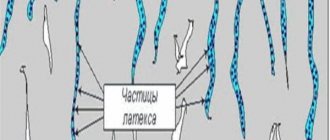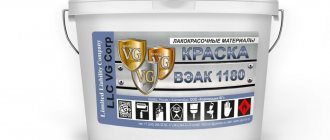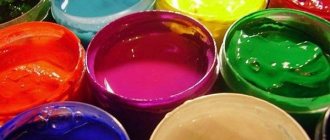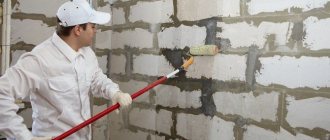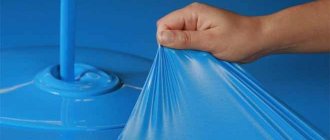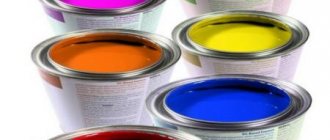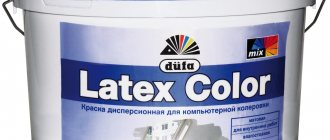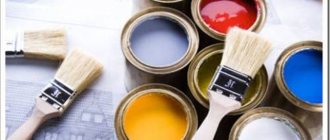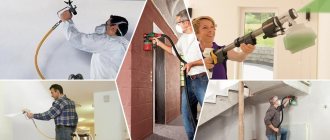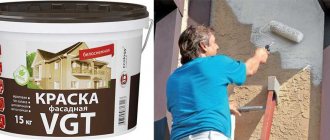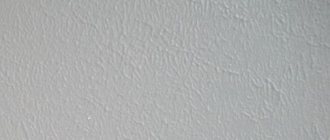Composition and features
Water-dispersed paint as a chemical compound is a mixture of tiny synthetic polymer particles and water, and the solid particles are not dissolved in it, but are suspended. Since the base is water, this paint does not burn. And after application to the surface, the water begins to evaporate, the filler particles move closer together, and the dried coating turns into a durable but breathable polymer film.
It is clear that if the solid particles did not interact with water, being completely immersed in it, then the finished coating would be very resistant to moisture.
Materials such as water-based dispersion paint and water-based paint are often confused, the differences between which are really insignificant, since a water-based emulsion is one of the types of dispersion systems, but the binding components in it are not in solid, but in liquid form, but they also do not mix with water.
Water emulsion under a microscope Source npfselena.ru
In addition to polymer fillers, dispersion paints may also contain mineral fillers - chalk, marble chips, talc. They improve their physical characteristics and affect their texture.
Also includes:
- binders (film formers), responsible for the formation of a film from dispersion components firmly adhered to each other and to the base;
- additives to improve the installation and performance properties of paint: its water resistance, resistance to fading, low temperatures, etc.;
- pigments to give color.
For reference! Water-based dispersion paint is produced mainly in white color; pigments are added to it before use.
After adding color, the paint is mixed until a uniform color Source couo.ru
See also: Catalog of companies that specialize in paints and varnishes and related work
Characteristics of dispersion paints
The quality of finishing materials depends on the characteristics and properties. Water-dispersed paint has four characteristics:
- Whiteness level. Often, materials for facades, as well as paints for interior work, are made in white. The required shade is created before work begins. The whiter the color initially, the brighter and more saturated the final color will be after adding coloring pigments to the paint. Titanium dioxide is responsible for quality and brightness. High-quality dioxide produces a brighter and whiter color.
- Covering power. This parameter affects the material consumption. Ideally, 1 liter of dye weighs 1.5 kg. If the product has a lower density, it means a large amount of water was added during production; if the density is higher, it means too much filler. In both the first and second cases, the hiding characteristics are reduced.
- Moisture resistant. The scope of application depends on this property. This characteristic indicates whether the paint can be used for interior work, or whether the material is suitable for outdoor use. The most non-moisture resistant are PVA. All others, including water-dispersed acrylic, withstand high humidity conditions and any cleaning methods well.
- Light resistance. This characteristic means how long the coating will not lose its attractive appearance when exposed to the sun. This property depends on the main substance in the dye. If the base is polyvylacetate, the dye is practically not subject to fading. Latex materials are suitable for finishing dark rooms.
For different types of finishing work, you should choose the appropriate material. For example, for work in hallways or basements, you can use latex dye. It fades under the sun, but the coating is durable and reliable.
Water-based or acrylic paints are better suited for interior work in damp areas. Acrylic-based dyes can also be used for facade work.
On video: characteristics of water-dispersion paint.
Types of high pressure paints
The type of material determines the main binder in its composition. These can be acrylic resins, polyvinyl acetate (familiar to all PVA) and butadiene styrene (synthetic latex).
- Water-dispersion acrylic paint is more expensive than other types, but due to its excellent characteristics, its scope of application is the widest.
- Latex dispersion is cheaper than acrylic, has higher moisture resistance, but is afraid of sunlight, fading or turning yellow with constant exposure.
- Polyvinyl acetate compounds are the cheapest, but their level of moisture resistance is low and they cannot withstand prolonged frosts.
PVA-based paints are used mainly for ceilings, as they “stain” Source market-crimea.com
Disadvantages of water-dispersed coatings
With all its advantages, water-dispersion paint also has features that many would consider disadvantages:
- The material can only be stored at room temperature (0...+30 °C). When overcooled, the dispersion deteriorates.
- VDC should be applied at temperatures from +5°C and humidity up to 80%. In other conditions, the coating film will not form (in the cold it will crack, and in high humidity the paint simply will not dry).
- Undried paint should be protected from precipitation for at least a day. In the first hours after application, rain will wash it away, and in the future it will shorten the service life of the coating.
- When painting in the heat or exposed to sunlight, the dispersion dries too quickly. Stains and brush marks remain on the coating.
- Water-dispersed coatings produce a thinner film than solvent-soluble ones. Because of this, the surface for their application must be prepared more carefully.
On a note! Water-based paints are more expensive than solvent-based paints. But at the same time, you can save on solvents for diluting the dispersion and washing instruments.
Water-based paints are much more expensive than others, but have a number of other advantages
Main advantages
Dispersion paint is made on the basis of water, and is brought to the desired consistency with it, without the participation of any solvents. This makes it harmless and eliminates the appearance of an unpleasant odor both during application and during drying.
Another advantage directly related to the water base is rapid drying, during which only water vapor is released into the surrounding space. For the paint to stop getting dirty and sticking to your hands, one or two hours is enough, some people need even less. And for the coating to achieve operational strength, a maximum of 4-6 hours is required.
The second layer can be applied within a couple of hours, which speeds up repairs Source uaeu.top
Advantages and disadvantages
We looked at what dispersion paint is. Now let's highlight its advantages and disadvantages. The first thing worth noting is that the product is safe and environmentally friendly due to the use of water as a solvent. The paint does not have an unpleasant odor, it does not burn, and mold and mildew do not form on the painted surface - this means that the paint breathes.
The lifespan of the dye is about 15 years. In this case, the material will not swell or crack. It takes about two hours for the layer to dry completely. Also among the advantages is the affordable price.
The material is easy to use and easy to use even without skills. Rollers or brushes are suitable for applying to the surface.
There are also disadvantages - the quality of the treated surface depends on the weather. Do not paint during precipitation or low temperatures. During precipitation, the water will not evaporate. Painting at high temperatures is also not recommended. Before starting work, you need to prepare the surface - you need it to be level. A thin layer of paint will not be able to hide unevenness. Another disadvantage is that the price may be higher than those products that use other solvents.
Where is it used?
Having studied all the characteristics of the material, it is easy to come to the conclusion that the scope of its application, although limited to internal work, is very extensive. You just need to carefully study the composition and recommendations on the packaging and correlate them with the requirements for the object being painted.
The most versatile application is water-dispersion acrylic paint, the technical characteristics of which allow it to be used for painting walls, ceilings, wooden cornices and baseboards, doors, and furniture. Moreover, both in dry and wet conditions, in living rooms and utility rooms. Acrylic paints can also be used for exterior work, but only if they have the appropriate marking or the name “facade”.
Rules for surface preparation before painting
Water-dispersed paint does not tolerate violations in painting technology. Any mistake can lead to it flying off the surface immediately after drying or, at best, for several months. To obtain a durable coating, you must follow the rules for preparing the surface to be painted:
- The first thing you need to do is remove dust, dirt, grease, mold, and loose old coatings from it. The best way is to rinse with a detergent solution, then with clean water.
- Before painting, walls and ceilings should be leveled with plaster and treated with a primer. Loose places should be strengthened or replaced.
- Areas affected by mold should be treated with a penetrating fungicide.
- Any damp surface should be dried before painting. In particular, the plaster, primer and fungicidal impregnation must be completely dry.
- Previously painted surfaces must be sanded to a matte finish to improve adhesion.
- Wood, on the contrary, should be sanded to achieve maximum smoothness.
Before using water-dispersion paint, the surface must be primed and thoroughly dried.
Differences between water-based paints
You already know what is the difference between water-based paint and water-dispersion paint in terms of chemical composition and structure. But for the consumer it is much more important which one has better characteristics. Let's compare the main ones.
- Moisture resistance is higher for dispersion paints (except polyvinyl acetate).
- Mechanical strength and abrasion are also better for dispersions.
- Aqueous emulsions win in terms of price - they are cheaper.
One of the most important characteristics of any paint is the degree of hiding power, the ability to properly paint the base. It cannot be said that water-emulsion paint is better than water-dispersion paint in this regard or vice versa. This indicator rather depends on the manufacturer and the technical conditions under which the composition is produced, as well as on its consistency.
Features of applying disperse paints
Painting with water-dispersed materials is as easy as painting with water-based emulsions. Even a person without special painting skills can work with them. But you need to consider the following:
- Immediately before starting painting, the paint must be thoroughly mixed.
- If it is necessary to tint the composition, the dry coloring pigment is first moistened in water and then mixed with the dispersion.
- Water-dispersed coatings can be applied with a brush, roller or spray gun. When painting large surfaces (walls, ceilings, floors), it is advisable not to use a brush - it is difficult to create an even coating with it.
- The compositions are applied in one or two to three layers (depending on the type of surface and paintwork).
Important! After applying the first layer of paint (varnish), the wooden surface must be sanded again to remove any raised lint. Without intermediate sanding, the finished coating will be rough and sloppy.
- Instruments after VDK cannot be washed with organic solvents. They cause coagulation of the polymer, and the pile becomes clogged with lumps.
To apply VDC it is better to use a roller; it allows you to create a more even coating.
Water-based paints have many features. But if you approach the selection and application of the dispersion with skill, you can easily get a beautiful, strong and durable coating.
Purchase and storage of coverage
On the Internet, on various industrial and construction portals, you can find a lot of proposals for the implementation of acrylic VDK.
Serious companies always guarantee the quality of any paint coating, provide it with reliable storage conditions, and they usually do not have any difficulties with delivery of the goods.
The presence of water in paint components creates some restrictions on storage and transportation methods.
Containers for these purposes must be made of corrosion-resistant materials - stainless or polymer.
VDK cannot be stored at sub-zero temperatures . The permissible freezing limit is no more than 5 times. Transportation is allowed for one month at a temperature of −20 °C, if this can be controlled. This is the only minor drawback for the consumer.
New technologies for the production of acrylic water dispersions make it possible to use their unique properties to coat almost any materials and structures, increasing their resistance to fire and corrosion.
They are not inferior in quality to pentaphthalic paints for painting wooden surfaces, but they dry very quickly and do not have toxic fumes with an unpleasant odor.
This encourages buyers to choose VD-AK and forget about the usual enamels and varnishes collecting dust on the shelves.
What is dispersion paint, what type of finishing work is it suitable for, and what are the advantages or disadvantages of this material - all this is useful to know when choosing paint and varnish materials for repairs.
Classification system
All funds of this type are divided into three groups. They differ in their main component or binder, as well as technical characteristics.
Water-dispersed polyvinyl acetate contain the main substance – polyvinyl acetate. These are so-called PVA paints. They have low resistance to moisture, so they are not used in rooms with high levels of humidity or for decorating facades. Dyes of this type are used for painting wallpaper, as paint for radiators, for wood and other surfaces located inside the building. These could be residential buildings or offices.
Latex
Water-dispersed latex paint is a substance made from latex. Has a lot of advantages:
- Forms a durable and reliable coating that is resistant to moisture and external influences. Latex paint can be used in damp areas, such as the bathroom or basement.
- The resulting washable surface is resistant to household chemicals and disinfectants.
The only drawback of the coating that latex paint creates is that over time it fades when exposed to sunlight. Therefore, it is advisable to use latex paint for indoor walls.
Acrylic
Another type of water-dispersed dyes is acrylic paint. This universal finishing material is used for interior work and as facade paint. The coating does not lose its attractive appearance over a long period of time, is resistant to moisture, and allows the surface to breathe, thereby preventing the appearance of mold. The coating does not crack and withstands mechanical stress very well. Paint consumption is significantly less than when using other varieties. This is due to its elasticity and good adhesion to the working surface.
Professional secrets for interior work
The paint can be used for indoor work, but the requirements must be followed. After covering the walls, the humidity level in the room increases. To quickly harden the layer, you need to install a fan.
To obtain an even coating, you must follow the following rules and recommendations:
To evenly cover a plastered façade, at least 3 layers of paint are required.
- application from top to bottom;
- first use a brush to paint over all hard-to-reach areas and irregularities;
- wait 4-5 hours between applying each layer;
- if the surface absorbs the material quickly and well, it is covered with 3-4 layers;
- before work, the plinths are removed;
- If you plan to paint the wall in several colors, you can use construction tape.
Ready-made stencils are intended for decorating walls. Recently, special rollers have appeared, the surface of which has a texture. They are used to create complex decorative elements.
Application methods
Several methods of painting surfaces are used in repair and construction work:
- brush;
- roller;
- air and airless spray.
Acrylic dispersion paint contains water, and this is the basis for the following rules:
- The material is applied at air and working surface temperatures of +5 °C and above (unless there are additional instructions).
- Do not apply to wet or unsanded surfaces painted with glossy paints.
- It is advisable to use corrosion-resistant painting tools. After work, they must be thoroughly washed and dried.
- During the application process, do not spill the prepared paint; after drying, it is very difficult to remove.
- You can start using painted products and surfaces no earlier than one day later. Despite the fact that the paint sets very quickly, the declared properties appear approximately a week after application.
Usually VDK is diluted with water without loss of consumer properties up to 5% by weight.
How are walls painted?
The walls are painted according to the same principle as the ceiling. But there are still differences. After all, this is a horizontal surface, and here is a vertical surface.
1. Use a brush to go through all hard-to-reach areas: in corners, under ceilings and at lower baseboards, near doorways. To avoid staining the latter with paint, apply masking tape to them. Remove it only after the paint has dried. That is, in 10-15 days.
3. Paint the wall not randomly, but in parallel stripes (vertical or horizontal) about 70 cm wide. They should overlap by about 10 cm.
4. Apply second, third, fourth (why not?) layers of paint. And so that the direction of the subsequent one differs from the previous one.
Are you afraid that the paint will lie unevenly? Light the wall with a carrying lamp. After all, all errors that are invisible in daylight are detected in artificial light.
For information on how to work with oil paints, read the article: “Painting surfaces with oil paints and enamels.”
How to properly plaster walls and ceilings, see the instructions at the link: https://remontspravka.com/stucco-wall-ceil/
